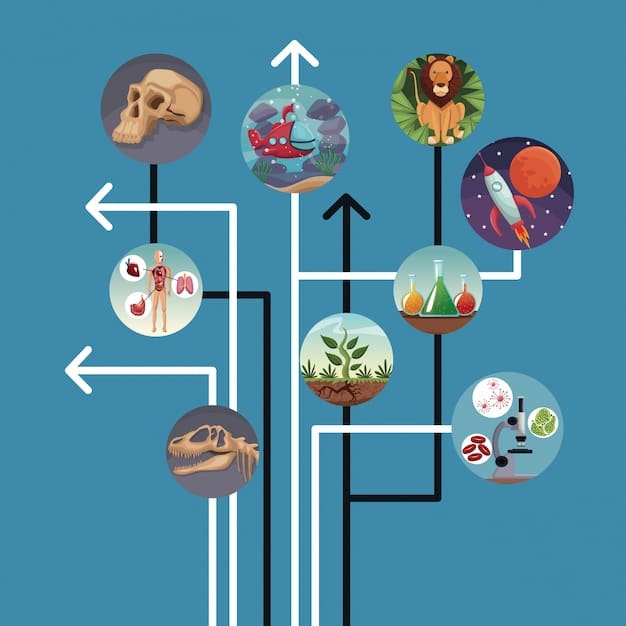Master Plotting & Pacing: Expert Reading List (Top 10)

The Reading List That Will Help You Master Plotting and Pacing: 10 Expert Recommendations offers a curated selection of books, recommended by seasoned authors and editors, designed to enhance your understanding and skill in crafting compelling narratives with effective plot structures and pacing techniques.
Are you looking to elevate your storytelling skills? Mastering plot and pacing is crucial for captivating your audience. This curated list, The Reading List That Will Help You Master Plotting and Pacing: 10 Expert Recommendations, compiles essential reads to help you do just that.
Why Plot and Pacing Matter in Storytelling
Plot and pacing are the backbone of any good story. They dictate how your narrative unfolds, keeping readers engaged from beginning to end. Understanding these elements is essential for any aspiring writer.
The Power of a Well-Crafted Plot
A strong plot provides structure and direction. It’s the series of events that drive your story forward, presenting challenges, conflicts, and ultimately, resolution.
The Art of Effective Pacing
Pacing controls the speed at which your story unfolds. Too slow, and readers might lose interest; too fast, and they might miss crucial details.
- Engage Readers: A gripping plot keeps readers hooked.
- Create Tension: Strategic pacing builds suspense.
- Deliver Impact: Well-timed reveals maximize emotional impact.
Mastering plot and pacing not only enhances the reader’s experience but also strengthens the overall message and impact of your story. By understanding these elements, you can elevate your writing to new heights, creating narratives that resonate long after the final page is turned.

Expert Recommendation 1: “Story: Substance, Structure, Style and the Principles of Screenwriting” by Robert McKee
Robert McKee’s “Story” is a seminal work on the principles of storytelling. It breaks down the mechanics of narrative structure in a way that’s both insightful and practical, applicable to both screenwriting and novel writing.
Why McKee’s “Story” is Essential
McKee deconstructs the myths and clichés of storytelling to provide a clear framework for crafting original and compelling narratives. He emphasizes the importance of understanding the underlying principles that make a story work.
Key Takeaways from “Story”
Learn how to build believable characters, develop meaningful conflicts, and create satisfying resolutions. McKee emphasizes the need for depth and authenticity in storytelling.
- Understand Structure: Learn the classic story structures and when to break them.
- Develop Characters: Create characters that drive the plot and resonate with readers.
- Master Conflict: Use conflict to create tension and forward momentum.
By understanding the principles outlined in “Story,” you can approach your writing with a newfound sense of confidence and clarity. McKee’s insights will help you craft narratives that are not only entertaining but also deeply meaningful.
Expert Recommendation 2: “On Writing: A Memoir of the Craft” by Stephen King
Stephen King’s “On Writing” offers a unique blend of memoir and masterclass. It provides invaluable insights into the writing process, combined with personal anecdotes and practical advice.
King’s Candid Approach to Writing
King shares his own experiences, both successes and failures, to illustrate the importance of perseverance, discipline, and self-awareness in the writing process. His candid and relatable style makes this book a must-read for aspiring writers.
Practical Advice and Personal Anecdotes
From overcoming writer’s block to developing your own voice, King offers a wealth of practical advice that you can apply to your own writing. His personal anecdotes provide encouragement and inspiration, reminding you that even the most successful writers face challenges along the way.
King’s “On Writing” is more than just a guide; it’s a conversation with a seasoned writer. His practical advice and personal anecdotes will inspire you to approach your writing with passion, discipline, and a deep understanding of the craft.
Expert Recommendation 3: “Save the Cat! Writes a Novel” by Jessica Brody
Jessica Brody’s “Save the Cat! Writes a Novel” adapts Blake Snyder’s screenwriting principles for novelists. It provides a structured approach to plot construction, helping you create a compelling and marketable story.
Adapting Screenwriting Techniques for Novels
Brody translates Snyder’s beat sheet into a novel-writing framework, providing a clear and concise roadmap for structuring your story. It’s a practical guide for writers who want to ensure their plot is engaging and satisfying.
Creating a Marketable and Engaging Story
Learn how to identify the key moments in your story, from the opening image to the final scene. Brody’s approach emphasizes the importance of pacing, conflict, and character development.
- Use the Beat Sheet: Follow the 15-beat structure to ensure a well-paced plot.
- Identify Key Moments: Understand the importance of each beat in driving the story forward.
- Engage Your Audience: Create a story that resonates with readers and keeps them hooked.
With Brody’s “Save the Cat! Writes a Novel,” you’ll gain a structured approach to plot construction, ensuring your story is engaging and marketable. It’s an invaluable tool for writers looking to create compelling narratives that resonate with readers and stand out in the competitive world of publishing.

Expert Recommendation 4: “The Anatomy of Story: 22 Steps to Becoming a Master Storyteller” by John Truby
John Truby’s “The Anatomy of Story” offers a comprehensive guide to crafting compelling narratives. It goes beyond basic plot structure, exploring the deeper elements that make a story resonate with readers.
Going Beyond Basic Plot Structure
Truby emphasizes the importance of character development, theme, and moral reasoning in creating a meaningful story. He provides a holistic approach to storytelling, encouraging writers to think beyond plot and focus on the deeper human elements.
Crafting Compelling and Meaningful Narratives
Learn how to create characters that are complex and relatable, develop themes that are relevant and thought-provoking, and craft stories that leave a lasting impact. Truby’s approach will help you elevate your writing to a new level of depth and sophistication.
Truby’s “The Anatomy of Story” provides a comprehensive guide to crafting compelling narratives that resonate with readers on a deeper level. His approach encourages writers to think beyond plot and focus on the human elements, developing rich characters and meaningful themes. This book is ideal for writers who seek to create stories with lasting impact.
Expert Recommendation 5: “Pacing for Emotion: Using Time to Maximize Emotional Impact and Add Tension to Your Writing” by Jamie Morris
Jamie Morris’s “Pacing for Emotion” delves into the often-overlooked but crucial element of pacing and its impact on emotional resonance within a story. This work offers writers practical tools and insights for controlling the ebb and flow of their narratives, making it an ideal guide for enhancing emotional impact.
Mastering Emotional Resonance Through Pacing
The book elucidates how to manipulate time within a narrative to enhance emotional beats and intensify tension, providing clear strategies to heighten the reader’s emotional investment.
Techniques for Adding Tension and Depth
Morris outlines various techniques to modulate pacing, from speeding up the action during climactic scenes to slowing down to allow readers to fully absorb moments of emotional significance, thereby constructing a more engaging and emotionally resonant reading experience.
- Time Manipulation: Techniques to speed up or slow down the passage of time to affect mood and suspense.
- Emotional Beats: Recognizing and enhancing moments of emotional significance to deepen reader engagement.
- Suspense Building: Strategies for pacing that maintain reader interest and heighten tension.
By focusing on how pacing influences emotional response, Morris provides writers with a unique and powerful toolkit to add depth, tension, and emotional complexity to their stories. This book stands out as a vital resource for novelists aiming to master the emotional landscape of their writing.
Expert Recommendation 6: “Writing Active Hooks: How to Snag Readers From Page One” by Mary Kole
Mary Kole’s “Writing Active Hooks” emphasizes the importance of engaging readers from the very first page through compelling hooks. This book is an essential guide for crafting openings that immediately captivate and retain audience attention.
Engaging Readers from the Start
Kole breaks down the elements of a successful hook and provides strategies for creating opening scenes that grab reader interest. She encourages writers to introduce conflict, intrigue, or a unique character early on to compel readers to continue.
Crafting Compelling Openings
The book offers exercises and examples to help writers develop active hooks that set the stage for the rest of the story. It teaches how to use the first few pages to establish tone, introduce key characters, and hint at the central conflict, all while maintaining a fast pace and high level of engagement.
Kole’s “Writing Active Hooks” offers writers the tools to create compelling beginnings that immediately draw readers into their stories. By stressing the importance of early engagement through intriguing characters and situations, this book is a valuable resource in mastering the art of captivating your audience from page one.
Expert Recommendation 7: “The First Five Pages: A Writer’s Guide To Staying Out of the Rejection Pile” by Noah Lukeman
Noah Lukeman’s “The First Five Pages” dives into the critical importance of making a strong first impression. The book’s primary focus is on refining the initial pages of your manuscript to catch the eye of agents and editors.
Refining the First Impression
Lukeman provides an analytical approach to editing the first pages, where he helps writers identify common mistakes that lead to manuscript rejection. The insights offered highlight vital adjustments in style, pacing, and presentation that can significantly boost a manuscript’s chances of getting noticed.
Essential Adjustments for Manuscript Success
This guide explores techniques to eliminate unnecessary words, refine scene settings, and enhance character introductions to make those first few pages as compelling as possible. The book illustrates how to polish your manuscript’s opening to secure interest from publishing professionals.
With “The First Five Pages,” Noah Lukeman offers a practical guide to ensure your manuscript makes a compelling first impression, making it an essential resource for any author hoping to navigate the competitive world of publishing.
| Key Point | Brief Description |
|---|---|
| 🌟 Plot Structure | Learn fundamental methods for structuring narratives. |
| ⏳ Effective Pacing | Enhance story speed to keep readers engaged. |
| ✍️ Compelling Hooks | Attract readers from the first page. |
| 🎭 Character Depth | Develop characters to enhance storytelling. |
Frequently Asked Questions
▼
Plotting gives your story a structured path. It ensures the narrative has a clear beginning, rising action, climax, and resolution, keeping readers engaged through a deliberate sequence of events.
▼
Pacing controls the speed at which events unfold. It affects tension and engagement; too slow, and readers might lose interest, too fast, and key details could be missed, diluting impact.
▼
Yes, while structure is crucial, it shouldn’t stifle creativity. Experiment with traditional forms but don’t fear deviation to better suit your story and unique narrative voice.
▼
A good hook immediately grabs the reader’s attention. It could be an intriguing question, a dramatic event, or a unique character introduction that sets the tone and presents conflict or mystery.
▼
Enhance emotional impact by developing relatable characters, exploring deep themes, and controlling pacing to create impactful moments. Authenticity and vulnerability are vital in connecting with readers.
Conclusion
Exploring these expert recommendations offers a comprehensive guide to mastering the essentials of plotting and pacing in your storytelling. Each book provides distinct insights, equipping you to create narratives that captivate, resonate, and leave a lasting impression on your audience.





